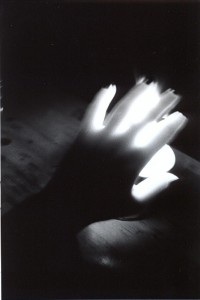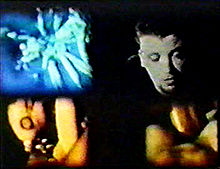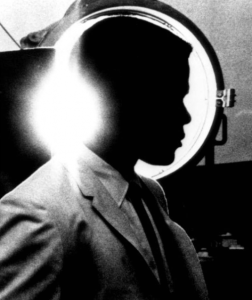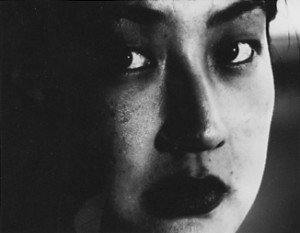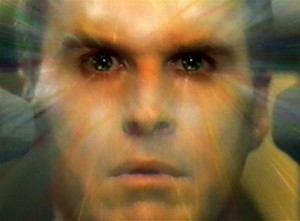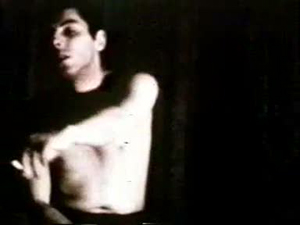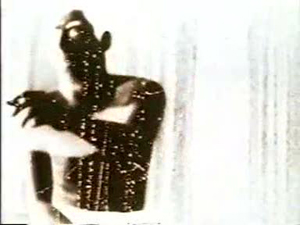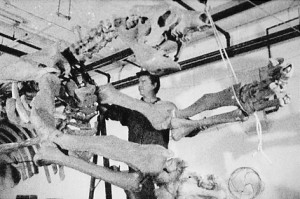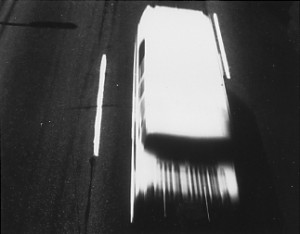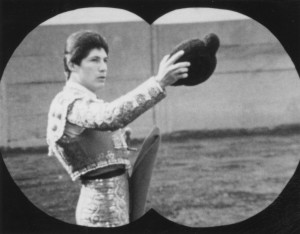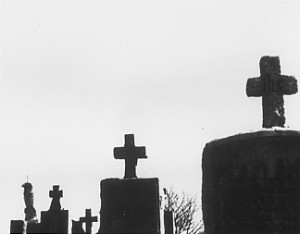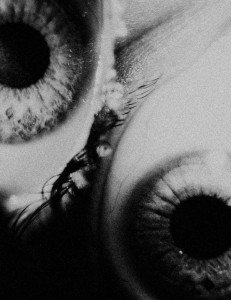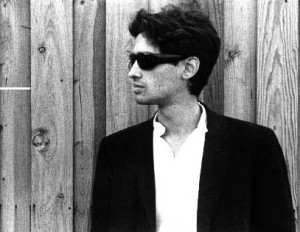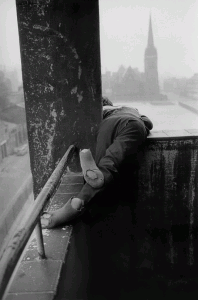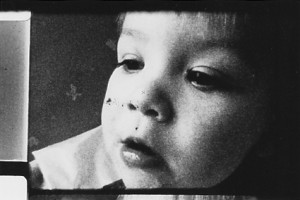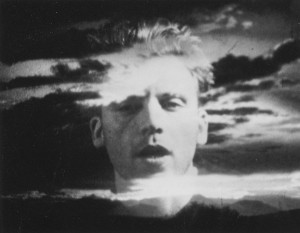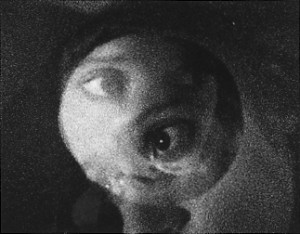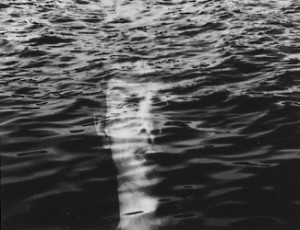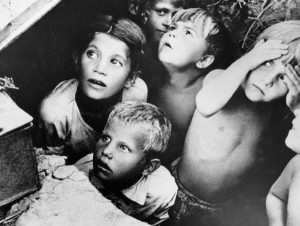
This is not the end: The films of Mike Hoolboom by Matthias Mueller (Vila do Conde Festival Catalogue, 2003)
A man looks at the camera and starts telling us about the long years of his loving relationship with Frank. During his monologue, which seems to be partly directed at us, partly at himself, the image is split into four parts. Interior and exterior views of the body, Madonna’s Erotica video, a hardcore gay porn movie and medical footage from the inner body are combined in a mosaic, forming a body of parts, the anatomy of a fragmented body which, in the age of AIDS, can no longer be experienced as an untouched whole. Only now do we begin to realize: Frank is dying. His lover is talking in retrospect.
In Frank’s Cock the feeling of distance and control caused by the rigid formal composition of the multi-screen psychodrama is gradually swept up into the increasingly intense performance of actor Callum Rennie. We are confronted with a unique destiny that is accompanied by disparate found footages—two parallel universes. Mike Hoolboom’s film displays the connection between them.
The advanced stylistic means used in Frank’s Cock are due, typically, to Canadian director Mike Hoolboom’s formal sophistication, which derives from his detailed knowledge of the history of experimental cinema that is always dedicated to producing work of relevant content. The way in which Hoolboom deals with his material shows profound experience in experimental image treatments which never become, in his hands, an end in itself, but which respond always to context and aesthetic strategy. Hand processing, high contrast printing, negative and solarization effects, tinting and other material transformations give Hoolboom’s films a sensual quality, which render a great many films usually considered to be erotic, pale by comparison.
Many of his films completely dispense with words, even including a feature-length film like House of Pain. Considering the powerful imagery of his films, it is remarkable that, in addition to his visual intelligence, Hoolboom also has a considerable literary talent, proved by, among other things, his two books, more than hundred essays and writings on various aspects of avant-garde cinema as well as a vast correspondence with other filmmakers. In the voice-over of his own films he speaks in a language that is both direct and poetic, helping him communicate with his audience. In the final analysis, all his work revolves around sharing experiences and creating communion. At the same time, his voice-over texts are open, associative and sufficiently fragmented to not annul the autonomy and ambiguity of the image, thus leaving free space for the audience’s thoughts. Rendered in a warm and suggestive voice, but at the same time insistent, oscillating between melancholy and tender irony, conciseness and sarcasm, the texts maintain a wonderful balance with the images.
In his autobiography Plague Years he writes, “Whenever I go to the hospital they don’t have to take any blood, they just read me like a book.” As the hand of a blind person feels the braille letters to sense the hidden meanings on the paper’s surface, Hoolboom’s camera feels his diseased body’s lesions in Passing On —as if it had to decode an encrypted message. Life and work, the body of the film and the body of the maker are almost indistinguishable in moments like these—and as in a diary, Mike Hoolboom’s work is revealed to us, written, sometimes as if by chance, at other times in a very self-reflective form.
Letters from Home: some of his works are based on letters—as a private and artistic means of expression, for instance his minimalist found footage-video Dear Madonna, in which the director superimposes on an industrial product of mass entertainment, the intimacy and spontaneity of communication among friends. In his short film Eternity, Hoolboom inscribes a letter from his friend Tom Chomont about his brother’s death onto images of a gloomy Disneyland.
Some years later, Hoolboom continues his correspondence with underground artist Tom Chomont in his meta-biographical feature Tom. In this film, images shot by Hoolboom are woven into a patchwork of found material, stock footage about the history of New York, excerpts of music videos and Hollywood movies and short extracts from Chomont’s own films and videos. “This is a biography about biographies,” says Hoolboom and therefore, the film’s perspective projects and re-projects Chomont’s portrait into the panorama of a city that never sleeps, the chronicle of a febrile age, a patchwork of minorities. From many points of view, Chomont is a figure of the fringe: as a subversive film artist chased by material deprivation and excluded from official recognition; as a member of the gay s/m scene, a minority within a minority; and as a sufferer of Parkinson’s and AIDS. Both Chomont and Hoolboom’s biographies are drawn together by a common illness—AIDS. Maybe it was his own disease that gave Hoolboom’s film such intensity and strength in understanding and which, in compensation, allowed Chomont to keep his dignity at all times, notwithstanding his many emotional breakdowns—or perhaps recover the dignity stripped from him by a repressive and unforgiving society.
In his soul mate, Tom Chomont, Hoolboom finds an example of inviolable and unmistakable identity. Years before, Hoolboom and his friend, filmmaker Steve Sanguedolce, travelled from their home country Canada, which was becoming increasingly American, to Mexico, as an allegedly more innocent country, only to end up concluding “that everything looked perfectly equal, everything you touch turns into Toronto.” The anti-travelogue Mexico describes a trip full of déja-vus. No matter what your eyes look at, “someone has come before you.” On the hotel’s TV screen we watch disaster and monster movies produced long ago in Hoolboom’s home town, relics of the cold war he insists, now deposited in Mexico where they appear as an infernal return. The filmmaker’s high contrast shooting keeps people at a distance, turning them into silhouettes, and when the film allows for tourist vistas it relegates them to the level of quotation, shot through a binocular mask. The journey ends where it has begun. “There is no escape.”
While the bright light of Mexico superimposes itself on all memories of the past, relics kept in the somber rooms of museums, Canada derives its cultural identity from a history kept alive by the media. The postcard motifs demanding consideration in Escape in Canada, produced one year after Mexico, show Canada as a country that struggles to bury all its internal contradictions, all its historical rejections and unfulfilled promises beneath the pompous invocation of a myth of a never-ending holiday paradise for Americans. As its sole stylistic device, Hoolboom is satisfied with solarization in order to distance himself from his material, disowning as propaganda this cultural artifact commissioned by the Canadian government and reconverting his objet trouvé into what it is in reality a mere accumulation of moving images.
Hoolboom’s found footage is never an aesthetic ennoblement or an overestimation of his finds. As the mass media consciousness industry extends itself to the private sphere, as Hollywood cinema projects itself into home movie models of representation, so Hoolboom finds, in the heterogeneous material that he collects from amateur and industrial cinema, numerous reflections and blueprints. His work questions the way we deal with the inherited images from our ancestors, which determine our concepts of life and death, as well as the way we represent ourselves in our own images. What images of ourselves will we leave to the following generations?
Hoolboom knows that memory can never be condensed into a single image, it is always a complex mixture of past and present, of what is our very own and what has been appropriated by us, of fact and fiction. His found footage work does not revolve around a specific isolated subject; it revolves around the totality (and the totalitarianism) of our global synchronized image-world. Newly homeless in his hands, images gather in clusters and generate complex, almost crystalline structures.
Hoolboom achieves this in a particularly impressive way in Last Thoughts from the cycle Imitations of Life in which he tries to give, in this condensed summary of a life, the shape of that proverbial film which seems to unfold before the eyes of the agonizing. The whole film consists of an array of images, bathed in water that sparkles, foams and bubbles in an enticing way and which washes off the distinct outline of the motifs, dragging them into a flow of other images. It is a mixture of angst and lust provoked by a mass of seductive waters. We are half-tempted to surrender to them or semi-resolved to defend ourselves from drowning. In several more recent Hoolboom films we find these ambivalent representations of death, perched between agony and the hope for salvation.
Hoolboom’s films navigate between individual and collective experience, they take their subjects from the most diverse sub-species of experimental film and also from popular cultural products, they fondle celluloid and an instant later, they apply the most advanced state-of-the-art techniques of digital image manipulation—thus escaping categorization. They are heirs to a vanguard that fought for formal innovation, reconciling it with the content-based practice of personal filmmaking. Though as soon as we attempt summary, we find the director has long ago escaped from limits, boundaries, definitions.
Meandering between short and long formats, sketched study and highly complex, multi-layered work, it is impossible to reduce the diversity of sexual representations in Hoolboom’s more than 40 films, to a common denominator. The films confront us with a physicality that rejects any label. Sexual preferences also seem undefined; their nature is always ephemeral. Hoolboom does not intend to escape, subversively, from common definitions, but he seeks the authentic and direct expression of a multiplicity (also: contradiction) of personal lives and social relations. In many ways, Hoolboom’s films document life in a state of transition. We graze across a variety of sexual shades, something as confusing as it is liberating. Alternately playful and obsessive, the unusually explicit representations of sexuality effectively turn his films into a Cinema of Transgression that surpasses by far the superficiality of the no-taboo stagings from the New York school. In Hoolboom’s films, sexuality is never used in a speculative form, it is always a vital, evident and authentic expression of identity.
Hoolboom’s own productivity and work frenzy corresponds to the frequently impetuous energy of these works; and since he contracted AIDS, the filmmaker’s productivity seems even greater: “After finding out I was positive my words congealed into sound bytes, my pulse quickening as I tried to finish a life’s work before sundown. It was a bit like racing blindfolded at the Indy 500—you sped up because you had to, bracing for the crash. This acceleration did wonders for my film production, and while my earlier movies were slow, open fields where viewers might gaze and push on, the new work turned behind a different pace car… These were movies born of fear. And isolation.” (Plague Years). A careful introspection helps Hoolboom overcome panic and isolation. “The body’s recollections, his memory, ensure that he is never totally alone, that he is always in the middle of a crowd scene.” (Passing On). Even though Hoolboom’s cinema belongs to the tradition of first person cinema, it has not a trace of egomania. He reflects his own existence with as much care and sensitivity as he has empathy with other people’s existence. For Hoolboom, making films is therefore something completely different from an alienated professional work—it is a conversational project, born from his own experiences and fueled by the need to communicate them, an enterprise that, at times, helps to annul the division of the world into myself and Other. As well as his own productions, his work is rich in collaborations with other directors, such as Steve Sanguedolce, Ann Marie Fleming and Caspar Stracke.
As unpredictable as the physical changes forced upon him by the disease, Hoolboom’s body of work is also packed with unpredictable transitions and flowing metamorphoses. These are moving pictures that stay moving—even after the final cut. Some motifs are repeated, with different connotations in different films. Some films coexist in an equivalent form in different versions, they work both as autonomous films and in the context of compilation features. In the love and travel diary co-produced by Kika Thorne, two, we successively see the same film twice, but in different sound versions: initially his, then hers. “This is not the end,” says the co-author at the end of her version, a sentence that could be The End of many Mike Hoolboom’s films.
Both in Eternity and in Tom, Tom Chomont describes a fragile white light that he imagines to be the beginning and end of all life. The farewell, loss and melancholy characterize Hoolboom’s new work, but his emotional strength and vitality also show confidence in that white light which is also the beginning of cinema. His disease gives him the opportunity of an existential experience which we are usually deprived of by the emotional balance required of us in a daily life committed to extreme functionality. As it is rightly experimental cinema’s infractions of the rules that sensitize our conscience to the mechanics and conventions of narrative cinema, to Mike Hoolboom, a body that no longer obeys any rule becomes an instrument that sharpens the senses for norms, ideologies and dogmas that were registered on it—and for the corresponding means of liberation. The more Mike Hoolboom’s recent films draw nearer to death, the more calmingly they seem to formulate the acceptance of its own finiteness: “At the end of your days there’s only that. To look into the abyss and smile.” (Hey Madonna). To the linear and simultaneously cyclic nature of life corresponds the paradoxical shape of the loop. The end embraces the beginning.
Imitations of Life describes one of these countercurrent movements, an attempt to find the future in the past. In the segment Jack, the filmmaker reflects himself in his nephew’s images, whose growth he has followed with his camera for more than nine years. Here we have an articulation of the anxiety of being able to recover the innocence of a child’s look unconfined in a fixed personality: “Jack happily washes away one self after the other.” In this touching revisitation of his own beginning, the filmmaker moves beyond the boundaries of home movies. With Hoolboom, home movies no longer display the will to preserve the present, but a yearning for another world, a second chance. In Passing On , Hoolboom remembers having loved and imitated, with his brother, death scenes on TV, “crawling and gasping our ways towards a perfect close.” Imitation becomes initiation, as, later, art will help Hoolboom to prepare for his own death.
“AIDS is a disease in stages, a long flight of steps that gives its afflicted time to die, time to discover time, and in the end to discover life.” (Hey Madonna) The radical challenge of this work and our great privilege as viewers consist in the possibility of being able to follow Mike Hoolboom in his spiritual journey of discovery, an adventure of vision. By his side, we can feel safe. As if the artist became invulnerable by pointing at his wounds, by undressing before our eyes, allowing us to look into his inner self, into his fears, his hopes, his sadness, Hoolboom trusts his means of communication to change his audience and thus change the world. “All rage begins in the place of sadness,” says Hoolboom in relation to Letters from Home, a film that associates different vignettes of people with AIDS, sending forth an impressive statement against ignorance and discrimination. “This war has not united us, it’s divided us.” It is not with the devices of stirring propaganda but with genuine artistic resources (and so, much more powerful) that Hoolboom manages to recreate a community between infected and healthy people—and this in an age in which all hope in the capacity of art to change things seems to have been annulled by total commercialization. His initial fury ended up giving way to much more complex and differentiated emotions.
The sensitivity and strength of his work, his dedication and trust in his means bring him close to Stan Brakhage, Hoolboom’s mentor, to whom, posthumously, he dedicated a tender hymn. Like Brakhage, Hoolboom has a considerable talent for translating images from the subconscious with imaginative richness and precision. Brakhage’s closed eyes visions keep on living in Hoolboom’s images—of changing light and reflections, of water surfaces in movement. Hoolboom also shares with Brakhage a vigorous rhetoric that helps him defend an overlooked art against all resistance and prejudice. In a letter to a dying Brakhage, Hoolboom remembers the presentation of one of Brakhage’s films, which was hand painted and had been destroyed by a deep scratch during its very first screening: “You stood calmly and talked about the marks of aging, the cost of going on, how the bodies of film and maker were growing old together. There was no way to guard against accident and illness, you remarked, not unless you shut your life up in a room.”
Mike Hoolboom decided to keep the doors of his room wide open for all of us. Our eyes see a body of work of great maturity and solidity, strong enough to immunize itself against all signs of physical decay and therefore, work that can be compared to the importance of canonized films from the history of avant-garde cinema that inspired Hoolboom himself. Nowadays an artistic stand such as Hoolboom’s is rare to see, shaped by an acute intelligence and formulated with an apparently tireless energy. All this makes Mike Hoolboom one of the most outstanding authors of contemporary cinema.
